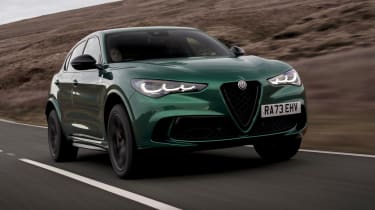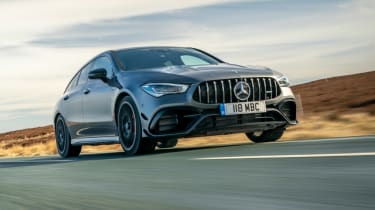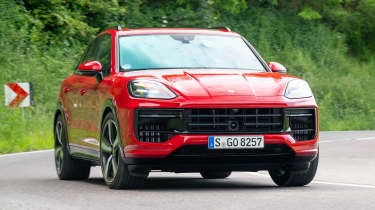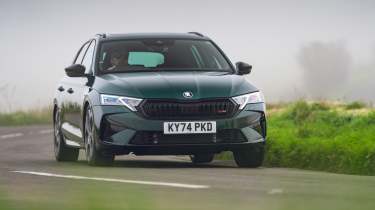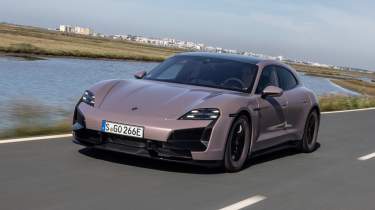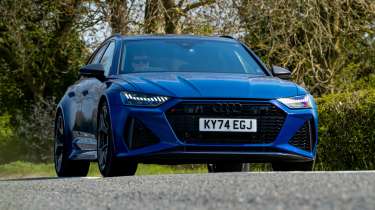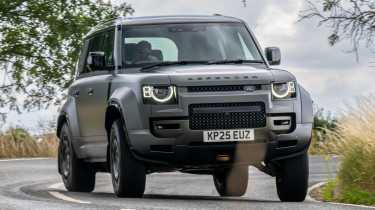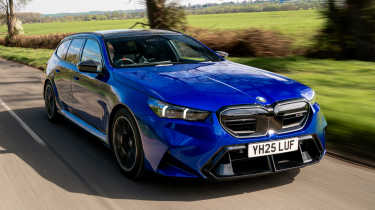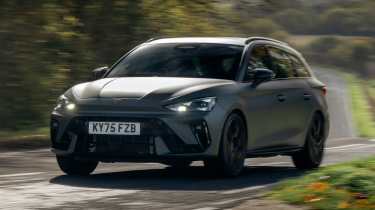Best fast family cars 2026 – practical performance cars for daily driving thrills
A family car doesn’t need to be dull – some of our favourite performance models deliver the thrills of a purpose-built sports car
Some of the most talked-about performance cars of the last 12 months are also cars you could conceivably run as your primary family daily driver. Hybrid, estate and SUV are not categories to stir the car enthusiast soul like ‘supercar’ or ‘sports car’. But some of these really are the best of their kind – do-it-all fast family cars – that we’ve ever driven.
In part that’s because car manufacturers are able to package more speed, more tech and more fun into family cars than ever before. Many practical, multi-purpose driver’s cars on sale today can now show a clean pair of heels to some bespoke sports car machinery, and while modern performance SUVs have stolen a march on this area of the market, the last few years have also produced some of the best fast estate cars in recent memory.
The SUVs we have included on this list don’t just drive well for their size and weight; they’re compelling in their own right, delivering memorable driving experiences irrespective of the genre they compete in. With that said, equivalent fast estate cars will always have a higher ceiling of performance, dynamic ability and – for us – desirability.
This is not an ordered list, rather a collection of brilliant-to-drive performance cars that place just as much emphasis on the way they drive as they do Isofix points. Having a family doesn’t mean you have to give up your performance cars. Sure, a family car will never be a direct replacement for your Aston Martin Vantage or Porsche 911, given that you’ll probably need some form of estate or performance SUV once little ones arrive, but fun, fast cars come in all shapes and sizes these days.
Best family cars 2026
- BMW M3 CS Touring
- Alfa Romeo Stelvio Quadrifoglio
- Mercedes-AMG CLA45 S Shooting Brake
- Porsche Cayenne GTS
- Range Rover Sport SV
- Skoda Octavia vRS Estate
- Porsche Taycan Sport Turismo
- Audi RS6 Performance
- Land Rover Defender Octa
- BMW M5 Touring
- Cupra Leon 333 Estate
BMW M3 Touring
Prices from £126,275
Pros – Incredible all-weather performance; genuinely agile
Cons – Not cheap
The BMW M3 is more usable than ever in its current G80 incarnation, particularly now that it comes with xDrive four-wheel drive as standard. It’s bigger than its predecessor with wide-opening doors and a generous boot, but most significant is the fact that you can buy an M3 Touring. Now that Touring body style has been given the CS treatment and though the M3/M4 family is not one that’s lunged for the heady heights that the M2 and M5 reached in CS trims, the Touring is, in our experience, the best of them.
The M3 CS is just about the best fast estate you can buy, with a crazy turn of speed, immense capability in the bends and a level of engagement that’s a match for almost anything with four doors. The CS Touring gets stiffer engine mounts and bespoke suspension calibration on top of the extra bracing in the rear structure the M3 Touring gets as standard, to achieve the kind of precision and finesse you would expect of a CS. The M3 Touring was a long time coming and surely worth the wait and then some. The CS Touring is the cherry on the cake.
‘It’s a lovely road car, with more grit and precision than a normal M3 but enough compliance to work with the road surface. The Cup tyres drum up a fair bit of noise on rough tarmac but, coupled with the suspension changes and a CS-specific aluminium front strut-brace, give the steering fantastic clarity. It’s measured, precise and relays surface detail to your hands through the (overly fat) suede rim.’ – Yousuf Ashraf, evo senior staff writer.
Alternatives to the BMW M3 CS Touring
The M3 CS Touring is without a direct rival for the moment, at least until the Audi RS5 Avant comes along next year. The RS4 Competition with its trick manually adjustable coilover suspension was a great sendoff for the B9-generation car but even with that and its Audi Sport differential, there’s no matching xDrive for its blend of traction and throttle adjustability. At M3 Touring prices, let alone CS prices, there’s also the option of a lightly used Audi RS6, should you crave a V8. Especially given Mercedes-AMG no longer offers one in the latest hybrid C63. A good alternative to a CS for a lot less money, lets not forget, is a standard M3 Touring...
Alfa Romeo Stelvio Quadrifoglio
Prices from £95,890
Pros – New diff works well; genuinely fun to drive
Cons – Interior less polished than rivals’; less fun than a Giulia
The Alfa Romeo Stelvio Quadrifoglio is on this list not just because it’s a more practical version of the brilliant Giulia, but because it has an exciting driving experience all of its own. This is underpinned by the Stelvio’s all-wheel-drive system, an element that fundamentally changes the way this car drives in comparison to the rear-drive Giulia.
The steering is quick and precise in the usual Alfa style, and the chassis balance almost makes it feel like a tall and Italian Nissan GT-R. It has a generous rear bias that gives this Alfa a high level of adjustability, especially in slippery conditions. And while the extra weight of the Stelvio is noticeable compared to its three-box relative, it’s not a deal breaker as the superb twin-turbocharged V6 still pulls with almost the same intensity.
> Alfa Romeo Stelvio Quadrifoglio review
‘The steering has a direct, pointy feel with a strong self-centring action, and that’s reflected in the Stelvio’s dynamics generally: it’s an agile car, which can change direction keenly and hunkers down under power, eking out traction and summoning a great deal of lateral grip. It feels far more nimble – and more fun – than the vast majority of performance SUVs.’ – James Taylor, evo Deputy Editor.
Alternatives to the Alfa Romeo Stelvio Quadrifoglio
The Stelvio Quadrifoglio isn’t long for this world, yet it has outlived some of its fiercest competitors, namely the BMW X3 M, which is yet to be replaced for the new generation. Nor is there anything like the old Range Rover Velar SVAutobiography, which brought a gargling supercharged V8 to the party. In a class of one, the Stelvio Quad’s most compelling alternative still sits alongside it in Alfa showrooms, albeit also on borrowed time, compelling one to ask whether the extra space and ride height is really necessary: the Giulia Quadrifoglio.
Mercedes-AMG CLA45 S Shooting Brake
Prices from £71,030
Pros: Same excellent performance and involvement as the A45
Cons: Price, Slight refinement penalty
If Mitsubishi was to ever make a modern Lancer Evolution estate (there was one, briefly, in its IX generation) it may well have ended up a little something like AMG’s brilliant small four-wheel-drive estate. The CLA45 S Shooting Brake borrows its hardware from the A45 S, with a stunningly potent 415bhp four-pot engine at its heart.
The CLA45 S takes the A45 recipe and repackages it in a sleek low-rise estate, with even more aggressive looks and a relatively big boot. We make the correlation to the Lancer Evo because the CLA has a sophisticated all-wheel-drive system with the ability to apportion power both front to back and left and right, giving it massive all-weather ability and a level of adjustability you’d expect from a WRC refugee. Buy one while you can though. This generation of AMG CLA won’t be around for much longer and isn’t likely to get a petrol-powered replacement.
> Mercedes-AMG CLA45 S Shooting Brake review
‘It’s as adept through corners too, despite the extra weight out back – positive steering, plenty of grip, and that feeling of the outside rear wheel over-driving as soon as you’re back on the power, first neutralising any understeer and then, if you’ve committed to your line, adding a little extra rotation so you can exit with the wheel perfectly straight.’ – Yousuf Ashraf, evo senior staff writer.
Alternatives to the Mercedes-AMG CLA45 S Shooting Brake
The small fast estate game isn’t a lucrative one at the moment but there are still some good options out there. Cupra’s Leon VZ estate always surprises with its talents and is £20,000 cheaper, even if it lacks the power, involvement and polish of the Mercedes. If you want something a little less serious, Audi’s S5 Avant is compelling, with a more charismatic engine somewhat making up for what it lacks in outright engagement compared to the stand-out talents of the Mercedes.
Porsche Cayenne GTS
Prices from £107,600
Pros – Class-leading dynamic quality
Cons – Not as plush as you’d expect for the price
In everything from its steering, balance and responsiveness, the Cayenne GTS is shot through with genuine Porsche DNA. It’s capable, polished and adjustable when the mood takes you, yet is adaptable enough to never be a hardship in day-to-day driving. The latest GTS gets a vocal 4-litre twin-turbocharged V8 with a nice, round 500ps (493bhp), and while it’s not as explosive as some of its rivals, it’s refreshing to drive a fast SUV that isn’t all about ripping up the road at the fastest rate possible.
As a family car, the latest Cayenne perhaps isn’t as sumptuous and luxurious as you’d expect inside, but the slightly clinical cabin is at least very well built, coming with Porsche’s latest suite of tech. This includes an optional infotainment screen ahead of the front passenger, with media streaming to keep them occupied on longer drives.
‘On tighter routes you appreciate the speed and directness of the steering, plus the torque vectoring diff’s ability to overdrive the outside rear to hold a tighter line. And since the V8 doesn’t catapult you between corners at warp speed, you can get into a rhythm with the GTS.’ – Yousuf Ashraf, evo senior staff writer.
Alternatives to the Porsche Cayenne GTS
None do a ‘lite’ version of their super SUV like Porsche does, so in a sense the Cayenne GTS is without a proper alternative. Audi’s SQ8 is more or less cut from the same cloth, albeit without much of the Cayenne GTS’s dynamic polish. For the money, a used RS6 would be too tempting to ignore.
Range Rover Sport SV
Prices from £139,000
Pros – Dynamic quality has sports car level of detail
Cons – Expensive, the answer to a question no one really asked
The Range Rover Sport SV isn’t as shouty, wild and aggressive as the Sport SVR it replaces, but it is emphatically more rounded and capable than its predecessor ever was. It’s a performance SUV that can stand toe-to-toe with the best that Porsche or Lamborghini have to offer, even giving one of the best examples of the breed – the Aston Martin DBX707 – something to think about.
At the SV’s heart lies a 4.4-litre twin-turbo V8, which generates the kind of colossal numbers we’re used to from today’s super SUVs – in this case, 625bhp and 590lb ft of torque. But it’s the Sport’s dynamic ability that really impresses, with hydraulically cross-linked suspension (the kind of tech you’ll find on a McLaren) keeping its body composed and controlled while remaining supple over poor surfaces. It’s as happy crossing continents in comfort as it is belting around a race track – at least while the tyres, fuel and brakes last… A point worth noting in 2026 for the SV? Now the Edition 1, Edition 2 and other introductory models with lots of standard features are sold out, it’s cheaper: a basic SV now starts from £139,000.
‘There is, of course, no need for a 635bhp, 2.5-ton SUV that’s as competent on track and the road as the SV is. But you can say that about so many cars, and the SV showcases technology that really does transform the driving experience for the better. Making such big cars more precise, and therefore easier to control and manage, has to be a good thing.’ – Stuart Gallagher, evo editor-in-chief.
Alternatives to the Range Rover Sport SV
The Range Rover Sport SV is punching upwards at badges with a higher standing than Land Rover’s own: those of Aston Martin (DBX707), Lamborghini (Urus SE), Porsche (Cayenne Turbo E-Hybrid) and even Ferrari (Purosangue). If your want is for a car that can perform impressively alongside them, that’s less outlandish (extraordinary to say of an RRS, we know) and more comfortable in its SUV skin, then believe it or not, the SV is a great choice.
Skoda Octavia vRS Estate
Prices from £41,715
Pros – Everyday performance; practicality; price
Cons – Interior materials; steering feel
We’re not sure there’s a more understated performance car on sale than the Skoda Octavia vRS Estate. Hiding beneath its hire car-spec exterior is an engine, gearbox and platform derived from the Golf GTI, with 261bhp being delivered to the front wheels in its latest facelifted guise.
To drive, the Skoda isn’t quite as sporty as it could be, but it has a wide range of ability thanks to optional 15-stage DCC dampers. In its softest setting the vRS settles into a relaxing stride, but there’s more control – and fun to be had – in its sportier modes. You can drive it like a big hot hatch, and on the inside, the Octavia is solidly built and comes with all the modern tech you could ask for.
Alternatives to the Skoda Octavia vRS
‘Apply throttle and the vRS picks up keenly in both estate and saloon guise, pulling you down the road and up to good pace without much thought – it’s not quite as quick as its lighter Golf GTI relative, but you don’t feel like you’re missing out on that extra performance.’ – Sam Jenkins, evo senior staff writer.
The Octavia’s keenest competitors are its Volkswagen group stablemates, the Cupra Leon 333 Estate and the Volkswagen Golf R Estate. The Cupra is the more flamboyant entertainer of the three, while the Golf is arguably the most understated. Both have all-wheel-drive over the Skoda’s front-drive setup. The Skoda trumps both in terms of value, with its £41k starting price below the £47k price point of the Golf and the Leon.
Porsche Taycan Sport Turismo
Prices from £97,200
Pros – Exceptional performance, range and dynamic ability
Cons – Hefty price; not roomy enough ; inconsistent brake feel
In this list we’ve explored today’s best fast family cars, but the Porsche Taycan Sport Turismo might just be the best fast family car of tomorrow. The Taycan has already proven itself to be a superb, fast and luxurious EV, handling with more composure than just about any rival, and it’s faster, more capable and more usable than ever in its latest Gen 2 guise.
With four-wheel drive, 590bhp and up to 383 miles of range, the 4S Sport Turismo would be our pick for a fast electric family wagon. It’s not as spacious inside as its size would suggest, but the Taycan is extremely well judged for comfort and composure. Specify Porsche’s Active Ride suspension system and its long distance credentials go up a level, with an uncanny ability to swallow bumps and keep the body stable. It’s hard to think of a more rounded and deeply talented electric car.
‘Its combination of style, polished driving dynamics and build quality – not to mention its ability to time travel when you plant the throttle – make it one of the most rounded EVs you can buy, more so than ever in Gen 2 guise.’ – Yousuf Ashraf, evo senior staff writer.
Alternatives to the Porsche Taycan Sport Turismo
Direct alternatives to the Porsche Taycan Sport Turismo are relatively few, given there are no estate versions of the Audi e-tron GT or Lotus Emeya. The new Audi S6 avant e-tron sits on the Premium Platform Electric (PPE) architecture that’s also the basis for the Macan EV, but doesn’t have the dynamism of the Taycan. There are plenty of alternatives powered by hydrocarbons (and some with a bit of electric), from the new BMW 550e and M5 Touring to the Audi RS6.
Audi RS6 Performance
Prices from £110,000
Pros – Rapid, capable and hugely enjoyable
Cons – You can’t order one new
Audi’s RS6 has been the king of big, fast estates for some time, but with BMW now aiming for the piece of the action with its M3 and M5 Touring models, Audi Sport has been forced to up its game. With the latest RS6 Performance it’s done exactly that, giving the C8-generation car an uptick in power and dynamic ability with very impressive results.
The RS6 doesn’t have the finesse of a BMW M product, but its crushing, bruising character and performance are deeply appealing. In Performance spec its 4-litre V8 generates a colossal 621bhp, and tweaks to the chassis have made harnessing that potential more rewarding than before. It digs in to find immense traction yet feels surprisingly agile for its size – it does things that frankly shouldn’t be possible for a 2090kg estate car. Get one while you can, as while there’s new stock, you can no longer order Audi’s best fast estate new. It’s to be usurped by a hybridised replacement next year, which as we found out with the M5, might not be a net gain…
The RS6 GT would have been our pick in its stead, if not for the fact it’s now sold out and used examples are priced in excess of £180,000…
GT spec includes three-way adjustable coilover suspension, stiffer roll bars and a retuned rear diff, and while there’s no more power than the RS6 Performance, you still get 621bhp from a 4-litre twin-turbo V8. The combined effect is spectacular, the GT feeling brutal and explosive with a newfound positivity and adjustability in its handling. It does things that frankly shouldn’t be possible for a 2075kg estate.
‘The RS6 exhibits all the characteristics so many enjoy about fast, modern Audis: a feeling of impenetrability, huge performance, long-distance refinement, and a well-built and practical cabin. And the C8 only adds to every one of these attributes.’ – Stuart Gallagher, evo editor-in-chief.
Alternatives to the Audi RS6 Performance
Alternatives to the Audi RS6 include the new BMW M5 Touring and Mercedes-AMG E53 estate, though neither are direct matches given both are full-on plug-in hybrids – the Merc isn’t the full-fat AMG V8 we’d traditionally pit against an RS6, either. A new RS6 is coming soon that will adopt hybrid power without ditching the V8.
Land Rover Defender Octa
Prices from £148,045
Pros – Dynamic qualities to rival a sports car
Cons – Where can you explore them fully?
When you think Defender, you perhaps think family car – not fast and definitely not fun in the evo sense of the word. The Octa however, has come along as the farm hand turned Cheshire school run express that’s been strong-arm engineered into one of the most interesting performance cars of 2025. And yes, that’s without losing much – if any – of the practical appeal.
Powering it is the familiar 4.4-litre BMW M V8 good for 626bhp, that’ll rocket it to 62mph in 3.8sec. But raw numbers don’t really do the genius of this car justice. The joy of the Defender Octa is facilitated by what’s going on underneath chassis wise. While wider to accommodate the longer wishbones and knobbly tyres, it’s the 6D suspension tech that’s the secret sauce. This is a hydraulically linked continuously variable semi-active damper system, that affords the Octa a sense of balance and control normally entirely alien to a Defender.
Able to control pitch as well as roll, the system adds a level of capability and pliancy you’d never expect. Off-road in Octa mode you can speed across a rutted green lane at speed like a trophy truck, while the more road-focused modes keep it tied down up to a point, allowing roll and yaw to a natural extent. It might sound odd but there’s an Alpine-like sense of carefully-curated body movement that makes the Octa a joy to thread up a road. And the rest of the time? Potholes and speed humps are a breeze. In some ways, it’s the perfect performance car for modern Britain…
> Land Rover Defender Octa review
‘This is a luxury super SUV that could dispatch a middling Pennine as a house spider would a shagpile rug; a performance car with a breadth of yobbery that includes being able to jump over a roundabout, as well as drift around it.’ – Ethan Jupp, evo web editor.
Alternatives to the Land Rover Defender Octa
Picking alternatives to the Defender Octa is difficult, given there’s nothing quite like it. For ostentatious urban presence, the obvious alternative is a Mercedes-AMG G63. In terms of off-road ability, not much comes close – a Lamborghini Sterrato or Porsche 911 Dakar could be considered rivals as off-road supercars, rather than the distinctly road-biased Urus or Cayenne Turbo E-Hybrid.
BMW M5 Touring
Prices from £116,095
Pros – Enormously capable; better-looking than the saloon
Cons – Range Rover weight; more ‘M550i’ than M5 in feel
We had hoped that BMW's M5 Touring might be all the supercar and family car one could ever need rolled into one. As it stands its weight, ride and how deeply buried its true M car character is within it stand somewhat in the way. Nonetheless the M5 Touring remains one of the most devastatingly effective and versatile performance cars money can buy right now. For its imperfections, the amount of sense it makes for a number of buyers, with its hybrid capability, business rate-friendly stated emissions and family-sized cabin is enormous. The 500-litre boot volume is a 34-litre upgrade compared to the saloon, with a much larger aperture through which to access it. What’s worth remembering however is that, thanks to the M5’s hybridity, it’s not as capacious as a lesser, non-hybrid 5-series Touring, which has a 570-litre boot unsullied by a big battery pack.
With 717bhp coming from a 4.4-litre twin-turbo V8 augmented by an in-transmission electric motor, the M5 Touring is monstrously fast, good for 0-62mph in 3.6sec. Unfortunately, while the battery (and motor) adds power, it also adds weight, on top of robbing boot space. Weighing in the region of 2550kg, it’s heftier even than the Defender Octa above.
It’s an infinitely configurable machine, though, which, set up just-so on the right road, can deliver proper M car thrills. The ride can be a bit crashy but the steering is well-judged and the brakes heave it to a stop to good effect. On top of being blisteringly fast, its rear-wheel steering and M differential bestow it with a rate of response you simply wouldn’t expect of a c2500kg car. You can also choose to send all of that grunt to the rear wheels for some typical M5 hooliganry.
‘Set the powertrain to Sport or Sport Plus and you get everything the V8 and electric motor can give, all the time, and the kick in the back is noticeably more savage. Just how well judged the base settings are is revealed when you switch the drivetrain to the more dynamic MDM. This sends more drive to the rear and on other 4wd M models is the setting of choice for setting lap times, giving an adjustable but effective dynamic balance.’ – John Barker, evo co-founder and editor-at-large, who drove the M5 on the launch.
Alternatives to the BMW M5 Touring
BMW’s M5 Touring returns to a marketplace that’s thinned out since its last outing. The Mercedes-AMG E53 estate doesn’t really fill the tyre tracks of the dearly departed E63 V8s. Fast estate masters Audi are still around with the RS6 Performance, the finest entry to the segment it’s ever devised. This year, that’ll make way for a new-generation RS6 with plug-in V8 power, to fight the M5 on equal terms.
Cupra Leon 333 estate
Prices from £41,330
Pros: Point-to-point pace, chassis balance, interior materials
Cons: Steering feel, price
If the Octavia vRS is almost perfect but a little staid for your tastes, might we recommend you consider its spicier Spanish cousin? The Cupra Leon estate in top-spec VZ trim comes with the hottest 326bhp EA888 you can currently buy, as well as the torque-splitter rear differential we enjoy in Audi’s RS3. It also gets some serious Sabelt bucket seats.
Add all that together with the impressively versatile DCC 15-way adjustable dampers and steering that’s more pleasant and direct than that on Volkswagen’s Golf R, and you have a package that surprises with its appeal. It’s agile, engaging and eager – it won’t thrill like a Civic Type R of course but its talents always confound relative to expectations.
‘Everything about the Leon just feels a bit keener, a bit more eager and more intuitive than the People’s Car equivalent. It’s more expressive and offers a clearer dialogue at speed, offering more clarity on how it wants to move around under braking or with agitated steering inputs. The four-wheel drive might make it more grown-up than the hatch but there’s still great fun to be had.’ – Ethan Jupp, evo web editor.
Alternatives to the Cupra Leon 333 Estate
Its price of over £50,000 (with those seats in its best form, it starts from £41,330) might be a little jarring but consider this: the next best things, an Audi S5 Avant or a BMW M340i Touring and Mercedes-AMG CLA45 S Shooting Brake start at over £70,000.
> Cupra Leon 333 Estate review


